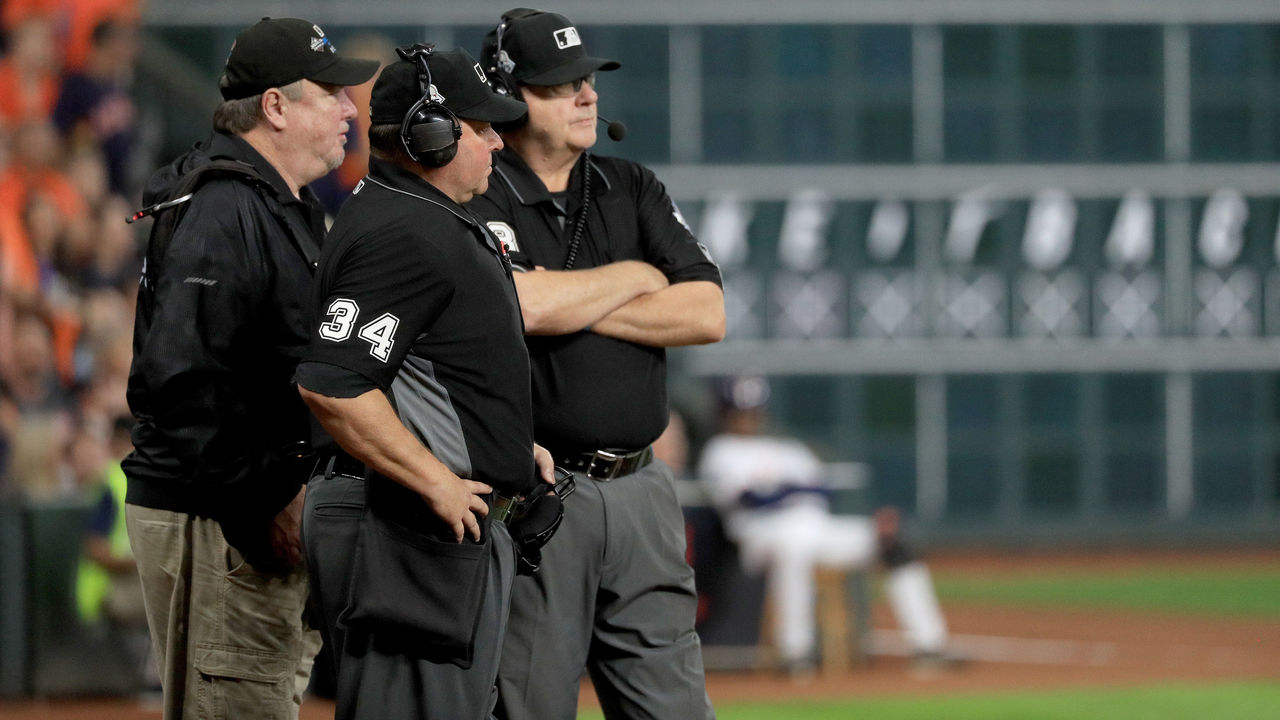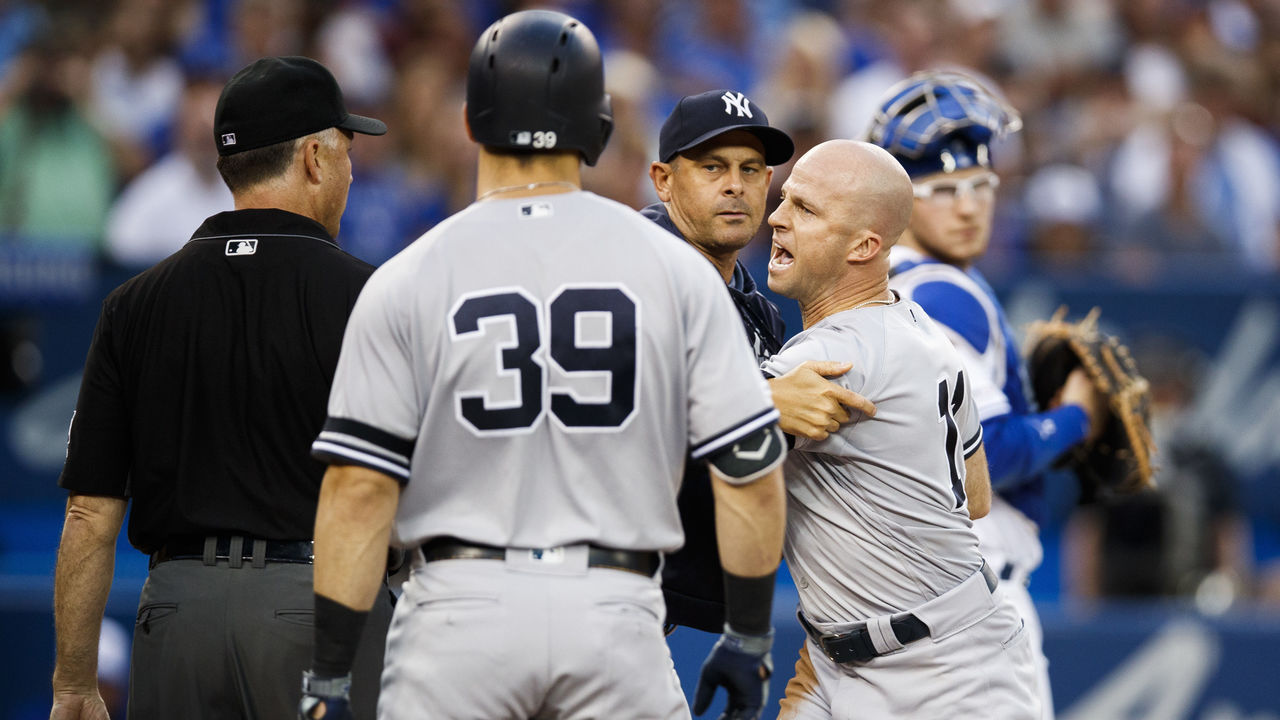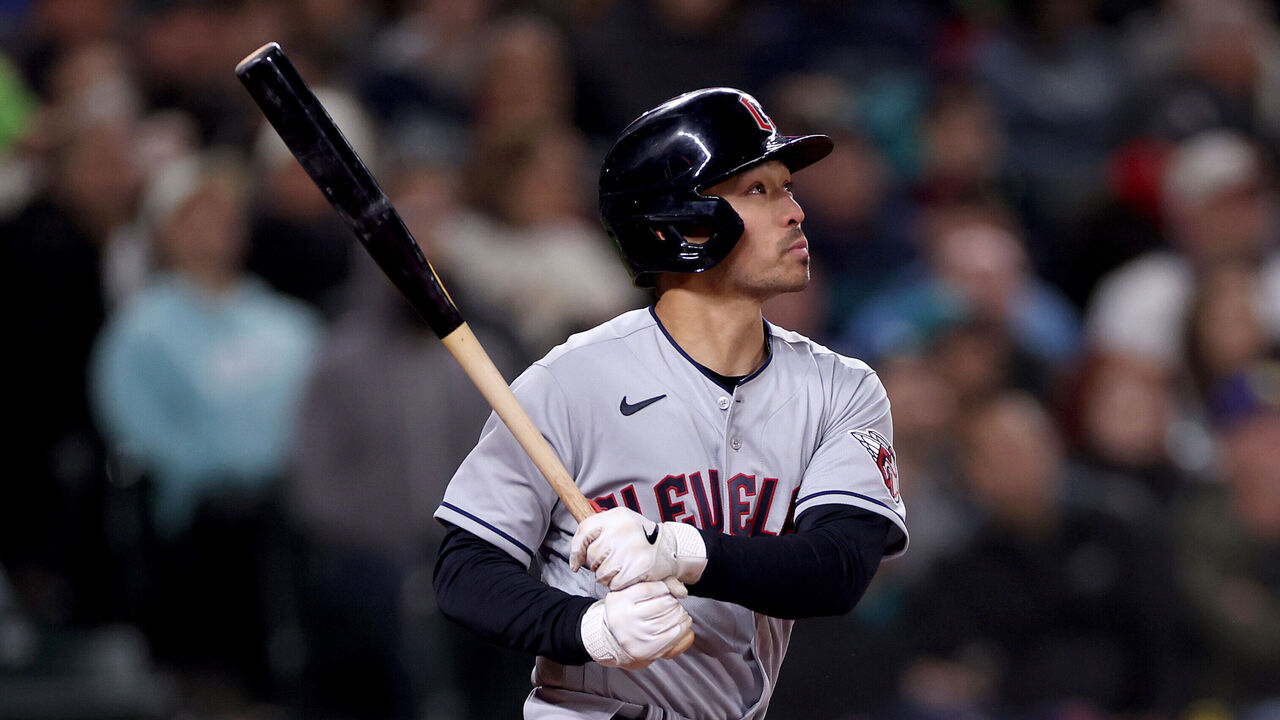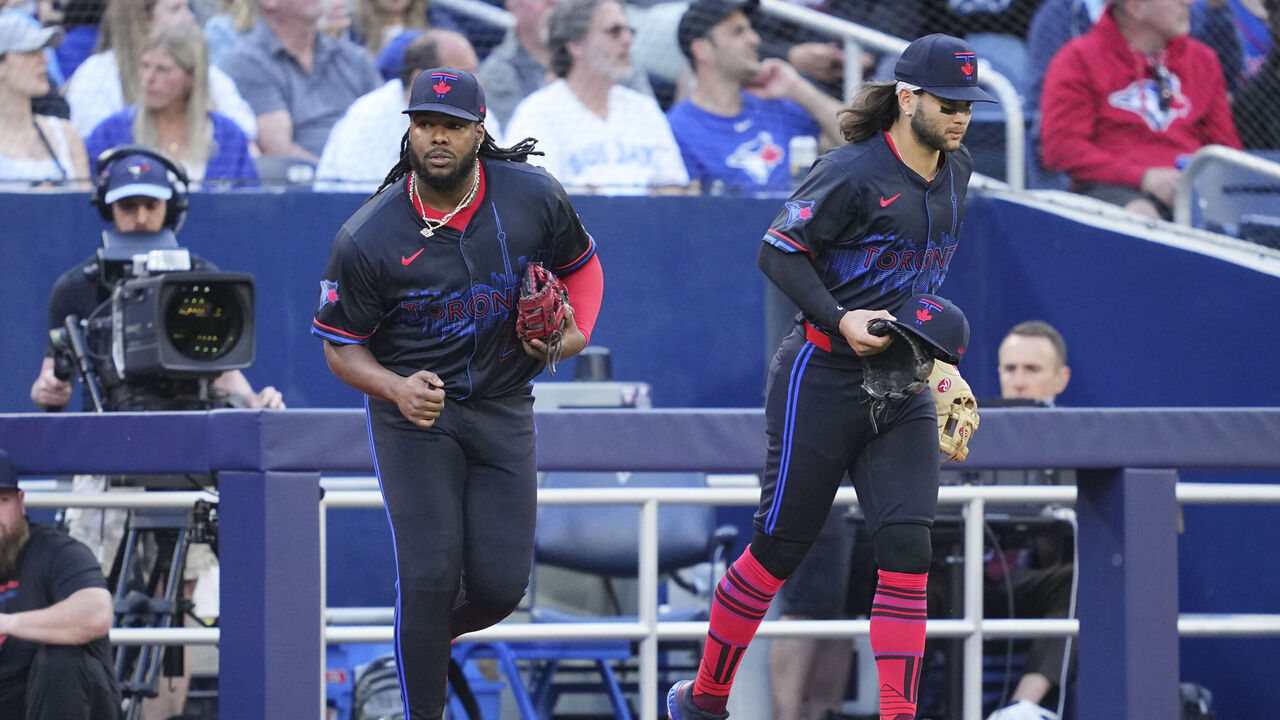Coming around on a challenge system, Kwan's chase, & more
Starting Lineup is a biweekly collection of reporting, observations, and insights from the baseball beat, published every other week during the regular season.
Leading off ...
Human umpires, while improved in recent years (yes, really), aren't getting enough calls right.
Nothing against us humans, but we aren't equipped to consistently judge whether a darting 90 mph slider clipped the corner of home plate. While umps have improved as they've trended younger and as they've received feedback from pitch-tracking grading systems, there are still too many missed calls.
Umpires get about 93% of called balls and strikes correct in recent seasons. Robo umps could push that number much closer to 100%.
There's a growing sentiment that in the not too distant future - 2026, perhaps - umpires will give some of their pitch-calling autonomy over to robots. The question is: how much of that autonomy?

Are we looking at a fully automated zone? Or a hybrid system where umpires make the majority of calls but players can challenge a handful of pitches per game?
Since 2019, MLB's conducted experiments with both approaches with their minor-league partners. But with news this week that all Triple-A games will now adopt the challenge system (the Triple-A schedule was split between challenge and full ABS systems), it seems likely a challenge system will be the first umpire-assistance approach implemented in the majors.
Personally, I favored full ABS over a challenge system.
If MLB can get 99-plus% of calls right with full ABS, why not choose that? Yes, the strike zone - its north and south portions - needs to be defined for individual batters, but the technology exists to tell us where the pitch is in a three-dimensional space. Players deserve accuracy, as do fans. Moreover, sports betting is becoming a significant business and more accuracy - and less human element - can't hurt in regard to that business, either.

But after considering arguments for the challenge system, and after speaking with and hearing from MLB players - like in Brandon Wile’s excellent piece - I've come around to the challenge system being the better choice, at least initially.
Why?
For starters, with a fully automated system, a catcher's receiving skills would often become nonessential, leading to negative aesthetic considerations - like lackluster receiving. In many cases, it wouldn't even matter if the ball was caught. The position could become akin to a second DH.
Receiving skills have been valued at the catcher position since the game's origin and discarding them overnight could have a number of unintended consequences.
I asked Guardians catcher Austin Hedges about the debate.
"It would be tough to take away a skill set that some people work their whole lives to get good at," Hedges said. "If we just got rid of the K-zone box that's on TV, there would be no complaints. That's the solution: don't show the strike zone. If you're watching a game on TV, watch with your eyes like the umpires have to."
And that leads to perhaps a more important point in favor of the challenge system: MLB's ultimately an entertainment product.
Having pitchers, batters, and catchers believe they know the zone better than the ump - and challenging them - will be entertaining.
And to Hedges' point, removing the real-time strike-zone overlay from telecasts to challenge viewers at home would also add an element of interest.
"I think it would be more entertaining," Hedges said.

MLB's a product that must become more entertaining to drive more interest. Compare its national TV media dollars to the NFL and NBA for proof. Any change that's fun and entertaining should be considered.
Finally, there's also the issue that the human strike zone - what we're all accustomed to - is actually larger than the rule book's strike zone.
When full ABS is employed in the minors, there are more walks, fewer strikeouts, and more home runs - it changes the nature of the game. While the zone parameters of a fully automated system could be defined to better mirror the human zone, the challenge system is basically the human zone with the most egregious calls eliminated.
Baseball America editor J.J. Cooper dug into the difference between full ABS and the partial challenge system:
One of these is the ABS zone's called strikes for a team. The other is the team's called strikes with the challenge system zone. https://t.co/fc5Htn8opA pic.twitter.com/VfvKN4pYDv
— JJ Cooper (@jjcoop36) June 19, 2024
In a sport so focused on optimization, perfection is perhaps not actually what baseball needs in this instance.
2. Bug or feature?
Entering play Saturday, there were nine National League teams either in possession of the last two wild-card spots or within two games of them, and none of those teams was above .500. Is keeping more teams in the chase a good development for MLB? Or do expanded playoffs reward too much mediocrity?
While playoff expansion keeps more teams involved, great teams drive interest and October TV ratings.
One thing we know for sure: playoff expansion and wild-card chases like this will do little to motivate owners to spend more on player payroll, especially after three 100-win teams lost in the division round last year.
3. Kwan's .400 chase
In the first inning Thursday afternoon in Cleveland, Guardians outfielder Steven Kwan ripped a double into right field. When he got to second, he was batting an even .400 on the season.
While he's short of qualifying for the batting title at the moment due to an injury earlier this season, that should change in early July.
A year after Luis Arráez brushed with .400 for half a season, Kwan's doing the same. He owns a similar batting profile to Arráez and is following a similar road map: they both spray line drives around the ballpark while avoiding strikeouts and pop outs.
Kwan owns a nearly perfectly balanced distribution of batted balls to left, center, and right field.
"It's a byproduct (of my swing)," Kwan said. "With my shorter arms, I can't really afford to pull an outside pitch. I just have to hit it where the pitch is."

Always an elite contact hitter, he's found another level this year in part because the club's scouting reports have been excellent this season, he said. He's also become more discerning and isn't trying to hit every pitch in the strike zone.
The final ingredient necessary for a hitter to make a run at .400 is power, to help push more fly balls over the outfield fence, and to propel more grounders through the infield.
To create more power and improve bat speed, the slight Kwan implemented a weighted-bat program last offseason. It's a similar constraint drill to that of weighted-ball programs for pitchers, designed to increase throwing velocity.
"The SparkNotes version: A bunch of swings with a heavier bat, you learn how to swing something heavy; then you transition to a light bat, so now your body understands what it feels like to whip a ball through a zone," Kwan said. "Bring it back to a regular bat, and then your body naturally (adds bat speed)."
He's tripled his career HR/FB ratio to date and owns a career-best exit velocity on pitches within the strike zone.
While his .412 BABIP is unlikely to be sustainable, Kwan's profile could make him a batting champion. He's already a good hitter and is becoming a great one.
4. Safety lane
Yankees first baseman Anthony Rizzo suffered a fractured right forearm last Sunday in an unfortunate way.
Rizzo was sprinting down the first-base line when Red Sox first baseman Dominic Smith threw behind pitcher Brennan Bernardino, who was covering the bag. Rizzo, running inside the baseline, collided with Bernardino, and Rizzo fell to the ground, his right arm taking the worst of it:
Anthony Rizzo left the game after this collision at first base. pic.twitter.com/ee4gurvVFR
— ESPN (@espn) June 17, 2024
MLB loosely asks that runners maintain position in the lane, but runners often don't. And if they do run in the lane, they have to go back to fair territory to touch first base. It's an awkward sprint.
What MLB should consider is an extended first base, a safety base, like we see in some amateur baseball or softball levels; an extended base that sits within the running lane. In other words: A direct path with less likelihood of injury - and more incentive for runners to stay in the lane.
5. Stumbling out of the gates
It was surprising to see the Blue Jays hold Spencer Horowitz out of the lineup Monday - and again Friday - against right-handed pitchers. The Toronto rookie is one of the team's few bright spots and enters play Sunday slashing .342/.444/.395 in 45 major-league plate appearances this season. He's often been slotted atop lineups when playing.
Toronto's desperate for a spark. Despite ending an agonizing 29-game first-inning scoreless drought earlier in June, the Jays have scored in the opening frame only 10 times (which is somehow not good for last place, as Toronto ranks 29th in first-inning scoring).
The Jays' season is on the brink and it's time to move on from struggling veterans.
6. Toronto's dilemma
The dilemma for the Blue Jays in potentially breaking up this team this summer is that core players Bo Bichette and Vladimir Guerrero Jr. have depressed value. It makes little sense to sell low on Bichette, who's injured and having a dreadful year, or Guerrero, who's hitting for average but not much power, at a time when even quality first basemen like Brandon Belt remain unsigned.

The most likely path will see Toronto keep Guerrero and Bichette but unload veterans on expiring deals like Yusei Kikuchi, or perhaps get a strong return for another pitcher with more control. Given the state of its farm system, any rebuild will be an extended retooling period in MLB’s toughest division.
7. Rickwood's rave reviews
While the "Field of Dreams" games were excellent, Thursday's game at Rickwood Field to honor the Negro Leagues in observance of Juneteenth was a greater and more meaningful event.
The venue and storytelling were excellent. If you have a few minutes, listen to Reggie Jackson explain what it was like to be a Black ballplayer in the deep south in 1967. It's raw, emotional, powerful stuff:
Alex Rodriguez asked a question. Reggie Jackson answered it.
— Gary Parrish (@GaryParrishCBS) June 21, 2024
(Shouts to the producer and rest of the desk for staying out of Reggie’s way and just letting him talk. I doubt they expected this answer. But it’s a great few minutes of television.)pic.twitter.com/7WqjlppvF8
What these games also teach us is that MLB can put on a game anywhere: from a cornfield in Iowa to the oldest ballpark in the country.
MLB would do well to expand the schedule to include other historic and interesting venues. There are other candidates for a rotating game to honor the Negro Leagues, for instance.
Ainsworth Field in Erie, Pennsylvania, hosted hundreds of Negro Leagues games - many played in by Josh Gibson - and still exists (though its entire playing surface would need to be rebuilt). League Park in Cleveland - the original home of the Guardians and the Negro Leagues' Buckeyes - still features a functioning baseball field with its original dimensions, along with remnants of its original structure.
Getting Rickwood Field ready for action. 😍 #MLBatRickwood pic.twitter.com/hdsJLMxicJ
— MLB (@MLB) June 21, 2024
The Rickwood Field and "Field of Dreams" games also underscore (and Fenway Park and Wrigley Field remind us regularly) that the most intimate venues are the best places to watch a ballgame.
8. Mets' non-Grimace X-factor
Consider this find from SNY reporter Steve Gelbs: Entering play Wednesday, the Mets were 18-1 in their last 19 games with Francisco Alvarez behind the plate (they're now 19-2 in their last 21 games with Alvarez).
Said Mets outfielder Brandon Nimmo to Gelbs: "I think he's the best, I love him."
Said veteran pitcher Jose Quintana: "I really love him."
The Mets heart Alvarez and for good reason: he has 70-grade power and a complete defensive skill set.

His return from the injured list is a big deal for the Mets, who are 8-1 with a plus-35 run differential since Grimace threw out a first pitch at Citi Field. The Mets are alive in a wide-open NL field.
9. Best quote in baseball
Relievers aren't usually go-to interviews for the press, but Rays closer Pete Fairbanks is becoming one of baseball's better quotes.
Earlier this season, Fairbanks offered an epic rant about his performance: "I thought it generally sucked. I didn't think it was a specific suck, I thought it was, like, an all-encompassing type of suck."
This week, he said he was trying to perform "within the realm of good," and later in the week, he spoke to reporters after a frustrating outing in which he destroyed some property in the visiting clubhouse at Target Field.
"I owe the Minnesota Twins visiting cage a new Ikea stool."
Pete Fairbanks adds another stellar interview to his montage reel.
— Evan Closky (@ECloskyWTSP) June 20, 2024
"I owe the Minnesota Twins visiting cage a new Ikea stool." pic.twitter.com/gAgAbhqN8T
Fairbanks may want to consider a career in TV once his playing days are over.
Travis Sawchik is theScore's senior baseball writer